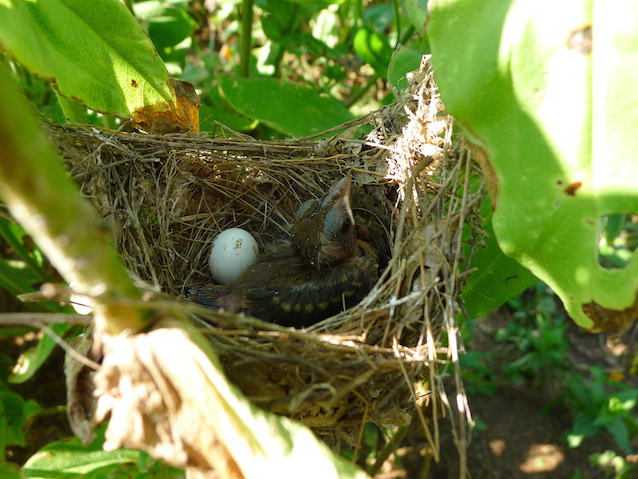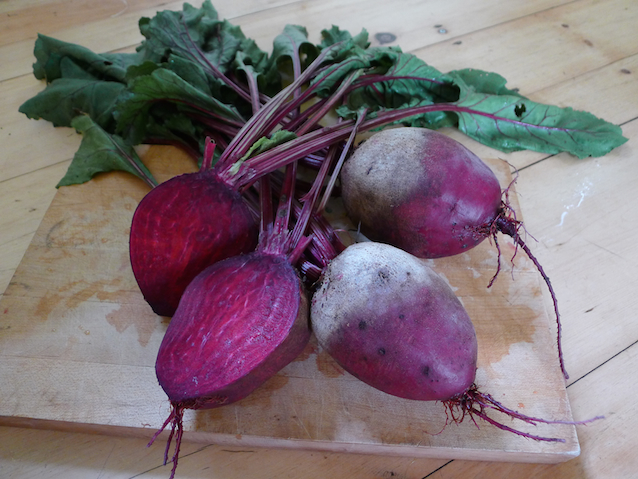
Hot, dry summer continued...

Imagine the work involved for a bird to build a nest like that, piece by piece. This one was found in the zinnias in the flower garden.

An unknown type of moth or butterfly attaches itself to a tithonia flower for a snack.
News
Notes From The Field
The Return of Irrigation
By Derek McGeehan
The Return of Irrigation
By Derek McGeehan
Last week I wrote about our appreciation for rain and the brief mental and physical break it gives us, or more accurately, a weekend almost off from work. This week the opposite feels true. For the first time in about three months we have to seriously consider adding water to the fields through drip tape and overhead sprinklers. Temperatures are forecasted to climb and there is no rain in the 10-day forecast, so we can't sit and wait for rain this time around. Fortunately the footprint of thirsty crops is a fraction of what it was a month ago thanks to many crops reaching maturity and the end of their life cycle. So, the time investment in setting up the infrastructure to irrigate should be less than it could have been and because we already irrigated much of the farm earlier in the season we'll be able to reuse all of the supplies that are mostly still out in the fields. Also, when we irrigate during the day most of our electricity demand to run the well pump is met by the electricity generated by the solar panels. Thank you sunshine and the grant that paid for the panels!

It has been rare to receive our beets with their greens still attached but with members' interest in the greens and the lack of leaf minor issues, they're back. Think of them as a spinach improvement and a chard replacement.
We continue our long march towards hibernation by cleaning up the fields, mowing, harvesting, removing trellising, sowing cover crops, and seeding and planting the final few rounds of vegetables. As the greenhouse and hoop house slowly empty and the direct seeded crops are sown, we begin thinking about other farm tasks to complete that get pushed to the offseason, ways to improve for next year, and what repairs need to be made. Of course, any extra time is now spent with irrigation, but that won't last forever. By the time it is all in place again it will probably rain.

Expected Harvest
Beets with Greens
By Derek McGeehan
Beets with Greens
By Derek McGeehan
Harvest #16 (Week B) should include beets with greens, kale, winter squash, lettuces, leeks, garlic, hot peppers, potatoes, sweet peppers, eggplant, okra, heirloom tomatoes, and watermelon. Some items will be a choice. U-pick should include green filet beans, edamame, husk cherries, tomatillos, parsley, dill, cilantro, basil, perennial herbs, and a flower bouquet.

Ways to Improve U-pick
By Derek McGeehan
By Derek McGeehan
We're brainstorming ways to improve the u-pick crops and experience for next season. Some of our ideas as of now include widening the walking aisles and taking a complete bed off in between rows of peas, husk cherries, tomatillos, and flowers; using the ground cover fabric to fully suppress grass and weeds; rotating the flower garden with the rest of the u-pick crops so that it isn't a separate and far away entity; and labeling varieties of cherry tomatoes. Please share with us any helpful suggestions you may have!

Workshifts Over For Season
By Derek McGeehan
By Derek McGeehan
Workshifts have ended for the year. If you weren't able to finish your hours, please send your $15 per missed work hour check made payable to "Anchor Run CSA" as soon as possible (half share - $60, full share - $120). This fills out the balance of your share cost and saves us the need to contact you for payment.

Beets are back!
By Linda Dansbury
By Linda Dansbury
Growing up, like many kids, I disliked beets, but now I truly enjoy them in many different ways - they can be eaten raw, roasted alone or along with other veggies, or boiled. After roasted whole, they are delicious made into a salad or added to other dishes such as Roasted Beets and Beet Greens or Roasted Beet and Beet Green Risotto. I mention these 2 dishes now because the beets will have their greens for at least the next 2 weeks (mother nature permitting). When you get your beets home, remove the tops, and place in a separate bag for storage. Although the beets will keep for a long time in the fridge, the tops are perishable and will only keep for up to a week.
Pumpkins will be in the pick up room this week - I know I won't be using my winter squash for at least the next few weeks, so I will be storing my pumpkin alongside my spaghetti squash and potatoes in the coolness of my basement.

Fermentation Workshop Cancelled
The Fermentation Workshop this year has been cancelled. Our sincere apologies to those planning to attend. If you would like some great books on fermenting, anything by Sandor Katz is a must.

The CSA Season and Winter Share
By Derek McGeehan
By Derek McGeehan
We're in harvest week #17 and are planning to go through 26 weeks. Immediately following this season is the Winter CSA which will probably run for 6 weeks again. New this year will be a half share option that will pick up every other week. There will still be the full share option that picks up every week. We're planning to try to better balance roots and storage crops with additional greens this year with the help of another moveable hoop house. The past two harsh winters taught us that we can't rely on outside crops with simple row cover frost protection. Bigger hoops and 6 millimeter thick transparent plastic provides 10 degrees of protection compared to 2-4 degrees from the row cover. Look for sign up and share details after Labor Day.

How I enjoyed my harvest this week
By Linda Dansbury
By Linda Dansbury
Beans, beans and more beans! I hope you are enjoying the bountiful harvests! Send me your ideas to lindadansbury@comcast.net.
Tomatillos, tomato, onions, hot peppers, cilantro - made tomatillo sauce to freeze for later use.
Beans - made Dilly Beans and canned them. They are basically a pickle in bean form - they stay nice and crunchy - just search the web for a recipe if you are interested.
Sweet peppers, onion, garlic, chili peppers - the bountiful harvest of beautiful peppers this year got me thinking: I didn't want to freeze all of them as I have other years. I sometimes purchase a hot pepper spread to put on my sandwiches, so I searched for a recipe that and found one that is a variation from a Ball recipe. The recipe called for 2 3/4 lb sweet peppers and 1/4 lb hot peppers. I only put two jalapenos in and it came out very spicy, but delicious. If anyone is interested, let me know and I will send you the link. I did not can mine, I put it in small containers to freeze and take out one at a time. With the vinegar that is added, each container will last a few weeks in the fridge.
Okra, potatoes - I parboiled both and then grilled them until nice and brown. When finished I mixed them together and drizzled with olive oil and a lot of parsley - really yummy! I could have grilled some tomatillos too, but had already used those up.
Edamame - boiled up and ate a few as snacks each day and froze a bunch of them. To freeze, once boiled I drain them well and then lay in a single layer on a cookie sheet and place that in the freezer. Once frozen, I place the beans into resealable freezer bags. They will be frozen as individual beans, so I can take out what I want through the year.
Eggplant, the last of the scallions, garlic, mint and Thai basil, hot pepper - made the Grilled Thai eggplant salad. Once I made it for the farmers market demo I craved it. I had made a few salads at the same time, so I had some of the eggplant salad leftover and I didn't get back to it for 3 days and it was still delicious.
Beans - made Dilly Beans and canned them. They are basically a pickle in bean form - they stay nice and crunchy - just search the web for a recipe if you are interested.
Sweet peppers, onion, garlic, chili peppers - the bountiful harvest of beautiful peppers this year got me thinking: I didn't want to freeze all of them as I have other years. I sometimes purchase a hot pepper spread to put on my sandwiches, so I searched for a recipe that and found one that is a variation from a Ball recipe. The recipe called for 2 3/4 lb sweet peppers and 1/4 lb hot peppers. I only put two jalapenos in and it came out very spicy, but delicious. If anyone is interested, let me know and I will send you the link. I did not can mine, I put it in small containers to freeze and take out one at a time. With the vinegar that is added, each container will last a few weeks in the fridge.
Okra, potatoes - I parboiled both and then grilled them until nice and brown. When finished I mixed them together and drizzled with olive oil and a lot of parsley - really yummy! I could have grilled some tomatillos too, but had already used those up.
Edamame - boiled up and ate a few as snacks each day and froze a bunch of them. To freeze, once boiled I drain them well and then lay in a single layer on a cookie sheet and place that in the freezer. Once frozen, I place the beans into resealable freezer bags. They will be frozen as individual beans, so I can take out what I want through the year.
Eggplant, the last of the scallions, garlic, mint and Thai basil, hot pepper - made the Grilled Thai eggplant salad. Once I made it for the farmers market demo I craved it. I had made a few salads at the same time, so I had some of the eggplant salad leftover and I didn't get back to it for 3 days and it was still delicious.

Member ideas and suggestions
By Linda Dansbury
By Linda Dansbury
This week I received three emails from fellow members about how to use the harvest. Thank you to Carol, Emily and Carolyn for taking the time! I know many of you have great ideas, so please send them to me at lindadansbury@comcast.net and please put Anchor Run in the subject line so I can find your email.
Carolyn Lyday writes about all the peppers we have been receiving. Read her entire post here for the wonderful suggestions. I have also added her recipe to the website for this week.
"We love peppers, sweet and hot and rarely have a hard time enjoying them. Besides the obvious--cutting them up in tossed salads, using them to scoop up hummus and other dips, chopping them up in scrambled eggs, adding them to quesadillas, roasting them and serving with chevre on a good baguette--here are some other things we've done this summer:
Pepper Slaw: Cut sweet peppers into 2"-3" strips and add them to the food processor with chopped cabbage to make a rough slaw to enjoy with hot dogs and baked beans (as well as other dishes, like green beans, sauted squash, and fried okra). We've added half a jalapeno to this as well, since we appreciate the heat. We add celery seed, salt, and pepper to taste, then a cider vinegar and mayo dressing. We leave out the customary sugar.
Sausage, peppers, & onions: We saute good Italian sweet sausages until nicely browned, remove from the pan, deglaze with wine or balsamic vinegar, add some olive oil if necessary, then saute the sliced peppers and onions until caramelized, add the sausage back to the pan to warm, and serve with mashed potatoes or rice (could also of course, serve on buns).
Pepper Puree: This recipe has been a welcome discovery for us this summer. The first time we made it, we accidentally included a hot pepper and loved it! We have used it on hot dogs and burgers and cheese sandwiches. We have spread it on dinner plates underneath grilled pork tenderloin and brown rice. We have served it with grilled chicken and used it to make bruschetta. We have served it alongside hummus and baba ganoush (yay, eggplant!) with pita. We have served it with couscous and other roasted or grilled veggies (great with cauliflower). I'm sure it would be good with eggs of all sorts (including deviled).
Emily Mahoney makes a lot of soups for her weekly lunches, no matter the weather since her office is kept so cold. Now is the time I start thinking about making full meals, including soups, to freeze for later use. Here is Emily's newest soup idea:
"Last night I made up a new soup recipe for my work lunches. It's an Okra and Rice Soup, and I made it to use up a lot of leftover farm share items I had from this past week, and frozen from previous weeks. It was delicious, and very hearty. It's pretty similar to gumbo, except that I didn't include any of the typical meats/seafood, and I added the rice directly to the soup, instead of serving over rice." I have posted her recipe.
Finally, Carol Barry Marini continued our dialogue on the chicken/pork with tomatillos in the slow cooker. She tried it with the chicken and also loved it and agreed with me that the veggies should be doubled to have a better ratio. Carol's additional suggestion is that once cooked, remove half the veggies and then use an immersion blender to puree the half still in the cooker, return the un-pureed veggies back in for a thicker, stew-like consistency. Carol is originally from the south and has been looking forward to okra, which she says is delicious roasted whole. I will have to try to just place them on the grill raw, rather than par boiled like I did before.
Thank you to Carolyn, Emily and Carol for sharing your wonderful ideas with the rest of the membership!

Recipes
V Pepper Puree
Original author unknown, submitted by member Carolyn Laydy.
2 pounds ripe peppers, red and/or orange
1/4 teaspoon salt
olive oil - about 1/4 cup, until desired consistency
Preheat the oven to 475. Line a roasting pan with enough foil to fold over the top later. Place peppers in the pan and roast, turning every 10 minutes, until they collapse, about 40 minutes. Alternately, grill the peppers, turning frequently until charred all over. Remove the pan from oven, fold the foil over peppers and allow to cool. If grilling, place in a paper bag and fold over until cool enough to handle.
1/4 teaspoon salt
olive oil - about 1/4 cup, until desired consistency
Preheat the oven to 475. Line a roasting pan with enough foil to fold over the top later. Place peppers in the pan and roast, turning every 10 minutes, until they collapse, about 40 minutes. Alternately, grill the peppers, turning frequently until charred all over. Remove the pan from oven, fold the foil over peppers and allow to cool. If grilling, place in a paper bag and fold over until cool enough to handle.
When cool enough to handle, working over a bowl to catch the liquid, remove and discard the pepper stem, core, seeds and skin.
Put the pepper pulp in a food processor with about 2 tablespoons of the liquid and 1/4 teaspoon salt. Turn on the processor and add the oil slowly through the feed tube. Taste and add more salt and oil as necessary.
This is great for bread dipping, and it's infinitely variable:
put a pool under roast or grilled chicken, red meat or fish; with fresh herbs
- add cumin, chili powder, caramelized onion or chopped raw garlic
; add 2 tablespoons to simmering liquid of rice or couscous
; add to tomato sauce at the end, or use instead of tomatoes
; add to omelets or scrambled eggs
; make a quick pesto with basil, grated Parmesan and garlic
; use with lemon juice, salt and pepper as a salad dressing
; on toast or pizza
; in stew or soup just before serving
; as an appetizer dip, with more oil, garlic, cracked pepper and salty cheese (feta, goat)
; as a finishing sauce for roasted eggplant or zucchini.

V Okra and Rice Soup
By Emily Mahoney (member); serves 4; takes about an hour to prepare.
1 large onion, chopped
1 clove garlic, minced
2 Tbsp olive oil
6 pieces okra, cut into 1/2 thick rounds
6 cups vegetable broth
1 cup chopped celery
1 cup chopped green beans
1 cup chopped scallions
1 cup chopped peppers
1 clove garlic, minced
2 Tbsp olive oil
6 pieces okra, cut into 1/2 thick rounds
6 cups vegetable broth
1 cup chopped celery
1 cup chopped green beans
1 cup chopped scallions
1 cup chopped peppers
2 cups cooked white rice
Cook chopped garlic and onion in olive oil in large stock pot until glassy. Add okra, continue to cook for a few additional minutes. Add vegetable broth, bring to boil. Add celery, green beans, scallions, and peppers. Let entire mixture simmer until it reaches desired consistency (I let it simmer for about half an hour).
Add pre-cooked rice to soup mixture, serve.


